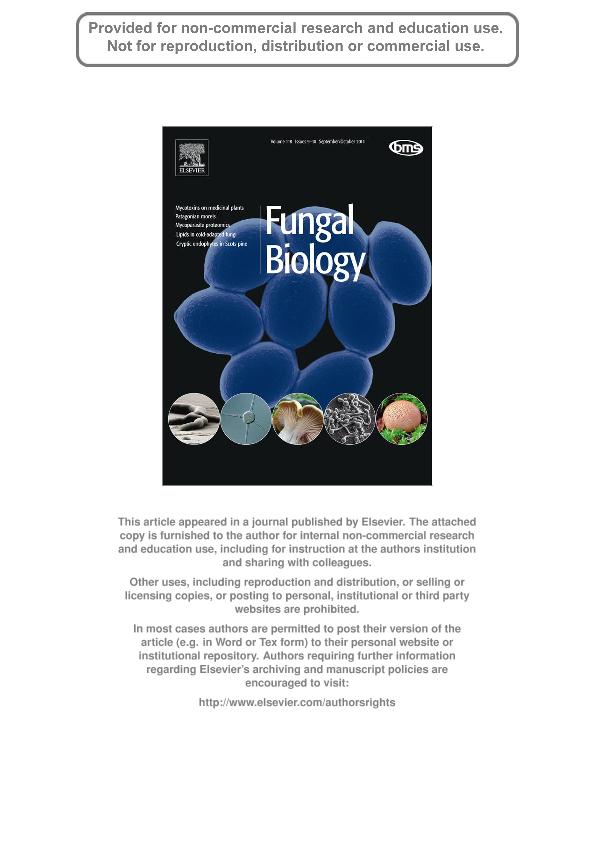Mostrar el registro sencillo del ítem
dc.contributor.author
Pildain, María Belén

dc.contributor.author
Visnovsky, Sandra B.
dc.contributor.author
Barroetaveña, Carolina

dc.date.available
2018-03-09T20:06:47Z
dc.date.issued
2014-05
dc.identifier.citation
Pildain, María Belén; Visnovsky, Sandra B.; Barroetaveña, Carolina; Phylogenetic diversity of true morels (Morchella), the main edible non-timber product from native Patagonian forests of Argentina; Elsevier; Fungal Biology; 118; 9; 5-2014; 755-763
dc.identifier.issn
1878-6146
dc.identifier.uri
http://hdl.handle.net/11336/38473
dc.description.abstract
Morchella species are edible fungi in high demand and therefore command high prices in world markets. Phenotypic-based identification at the species-level remains inadequate because of their complex life cycles, minor differences and plasticity of morphological characteristics between species, and the lack of agreement between scientific and common names. In Patagonia-Argentina, morels are associated with native forests of Austrocedrus chilensis (Cordilleran or Chilean cypress) and Nothofagus antarctica (ñire) and several exotic conifers that were introduced from western North America. Little is known about their taxonomy and phylogenetic relationships with other species in the genus. This work focused on the identification of collections of Morchella from Patagonia and their phylogenetic relationships with other species from the Northern Hemisphere. The comparison was made by analysis of DNA sequences obtained from four loci: the nuclear ribosomal internal transcribed spacer region (ITS) and the partial RNA polymerase I gene (RPB1) for the complete collection; and ITS, RPB1, RNA polymerase II gene (RPB2), and translation elongation factor (EF1-α) for the species-rich Elata Subclade. Analyses of individual and combined data sets revealed that Patagonian morels belong to the Elata Clade and comprised three strongly supported species-level lineages from both Patagonian native forest, and exotic trees introduced from western North America. One lineage was identified as Morchella frustrata phylogenetic species Mel-2, which is known from the USA and Canada. The second lineage, which appeared to be 'fire-adapted', was identified as Morchella septimelata phylogenetic species (Mel-7), which is also known from the USA. This species was collected from burned native forests mainly composed of A. chilensis and N. antarctica but also Pseudotsuga menziesii (Mirb.) Blanco, which is native to western North America. The phylogenetic analyses suggested that the third species from Patagonia was nested within the species-rich Elata Subclade and represents a new species-level lineage (informally designated Mel-37) within Elata Clade. The present collections from Patagonia constitute the southernmost latitude from which Morchella has been reported to date. The identification of two Argentine morels as North American taxa is therefore a remarkable biogeographic pattern. In view of the hypothesis that the Elata Clade originated in western North America, we speculate that at least two of the lineages colonized South America from North America via long distance dispersal, migration or, more likely, they were introduced with the exotic tree species that they were collected near.
dc.format
application/pdf
dc.language.iso
eng
dc.publisher
Elsevier
dc.rights
info:eu-repo/semantics/openAccess
dc.rights.uri
https://creativecommons.org/licenses/by-nc-nd/2.5/ar/
dc.subject
Elata Clade
dc.subject
Exotic Tree Species
dc.subject
Native Forest
dc.subject
Phylogeny
dc.subject
Species-Rich Elata Sublcade
dc.subject.classification
Otras Ciencias Biológicas

dc.subject.classification
Ciencias Biológicas

dc.subject.classification
CIENCIAS NATURALES Y EXACTAS

dc.title
Phylogenetic diversity of true morels (Morchella), the main edible non-timber product from native Patagonian forests of Argentina
dc.type
info:eu-repo/semantics/article
dc.type
info:ar-repo/semantics/artículo
dc.type
info:eu-repo/semantics/publishedVersion
dc.date.updated
2018-03-09T19:00:01Z
dc.journal.volume
118
dc.journal.number
9
dc.journal.pagination
755-763
dc.journal.pais
Países Bajos

dc.journal.ciudad
Amsterdam
dc.description.fil
Fil: Pildain, María Belén. Universidad Nacional de la Patagonia; Argentina. Centro de Investigación y Extensión Forestal Andino Patagónico; Argentina. Consejo Nacional de Investigaciones Científicas y Técnicas; Argentina
dc.description.fil
Fil: Visnovsky, Sandra B.. Plant & Food Research; Nueva Zelanda
dc.description.fil
Fil: Barroetaveña, Carolina. Universidad Nacional de la Patagonia; Argentina. Centro de Investigación y Extensión Forestal Andino Patagónico; Argentina. Consejo Nacional de Investigaciones Científicas y Técnicas; Argentina
dc.journal.title
Fungal Biology
dc.relation.alternativeid
info:eu-repo/semantics/altIdentifier/doi/http://dx.doi.org/10.1016/j.funbio.2014.03.008
dc.relation.alternativeid
info:eu-repo/semantics/altIdentifier/url/https://www.sciencedirect.com/science/article/pii/S187861461400049X
Archivos asociados
